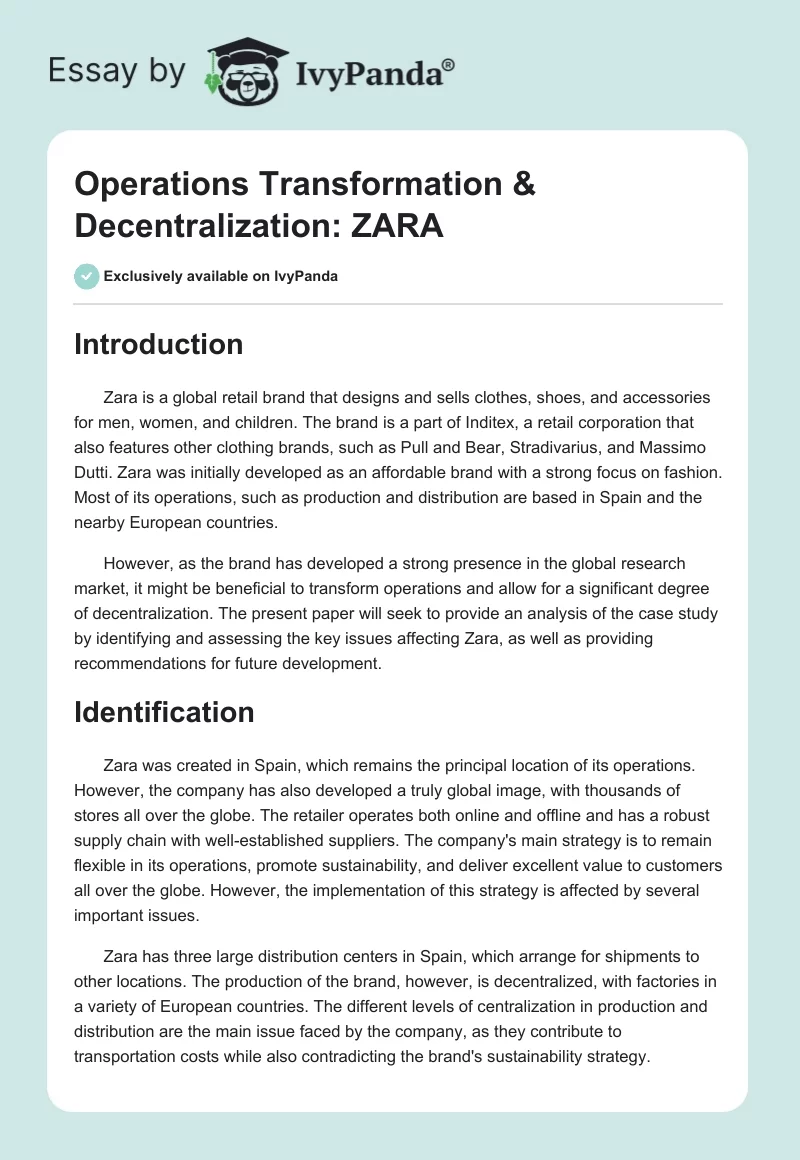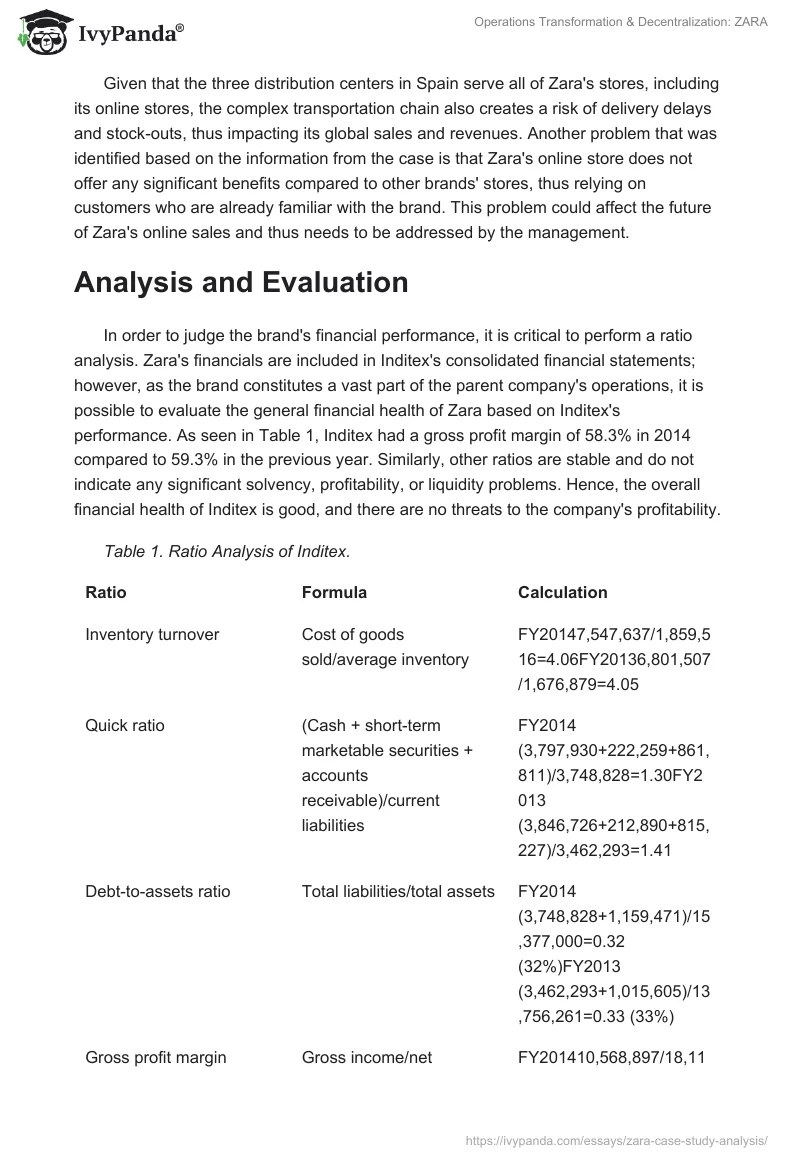Introduction
Zara is a global retail brand that designs and sells clothes, shoes, and accessories for men, women, and children. The brand is a part of Inditex, a retail corporation that also features other clothing brands, such as Pull and Bear, Stradivarius, and Massimo Dutti. Zara was initially developed as an affordable brand with a strong focus on fashion. Most of its operations, such as production and distribution are based in Spain and the nearby European countries.
However, as the brand has developed a strong presence in the global research market, it might be beneficial to transform operations and allow for a significant degree of decentralization. The present paper will seek to provide an analysis of the case study by identifying and assessing the key issues affecting Zara, as well as providing recommendations for future development.
Identification
Zara was created in Spain, which remains the principal location of its operations. However, the company has also developed a truly global image, with thousands of stores all over the globe. The retailer operates both online and offline and has a robust supply chain with well-established suppliers. The company’s main strategy is to remain flexible in its operations, promote sustainability, and deliver excellent value to customers all over the globe. However, the implementation of this strategy is affected by several important issues.
Zara has three large distribution centers in Spain, which arrange for shipments to other locations. The production of the brand, however, is decentralized, with factories in a variety of European countries. The different levels of centralization in production and distribution are the main issue faced by the company, as they contribute to transportation costs while also contradicting the brand’s sustainability strategy.
Given that the three distribution centers in Spain serve all of Zara’s stores, including its online stores, the complex transportation chain also creates a risk of delivery delays and stock-outs, thus impacting its global sales and revenues. Another problem that was identified based on the information from the case is that Zara’s online store does not offer any significant benefits compared to other brands’ stores, thus relying on customers who are already familiar with the brand. This problem could affect the future of Zara’s online sales and thus needs to be addressed by the management.
Analysis and Evaluation
In order to judge the brand’s financial performance, it is critical to perform a ratio analysis. Zara’s financials are included in Inditex’s consolidated financial statements; however, as the brand constitutes a vast part of the parent company’s operations, it is possible to evaluate the general financial health of Zara based on Inditex’s performance. As seen in Table 1, Inditex had a gross profit margin of 58.3% in 2014 compared to 59.3% in the previous year. Similarly, other ratios are stable and do not indicate any significant solvency, profitability, or liquidity problems. Hence, the overall financial health of Inditex is good, and there are no threats to the company’s profitability.
Table 1. Ratio Analysis of Inditex.
The financial information of Inditex also shows that the company’s capital structure relies predominantly on equity, although it also uses a significant share of current liabilities, mainly trade and other payables (Inditex 189). The share of non-current liabilities in the capital structure is low, which shows reduced reliance on financial debt and reduces the long-term financial risk for Inditex.
Based on the information in the case and the financial information available, the key strengths of Zara are its established position on the global scene and excellent supply chain management. The case shows that Zara fosters long-term relationships with most of its suppliers and has an extensive network of reliable supplies of products and raw materials. Nevertheless, stability in financial results despite opening new stores also indicates that the brand’s competitive position is not improving. Enhancing operations, promoting sustainability, and increasing the volume of online sales would help Zara to strengthen its competitive position.
Recommendations
There are two main recommendations that can help Zara to resolve its key problems. First of all, it would be helpful for Zara to improve distribution by opening regional distribution channels that would receive products straight from production facilities instead of the three main distribution centers in Spain. The proposed action plan here is to open regional distribution centers in North America and Asia and establish transportation of products from production facilities in Europe.
Secondly, Zara would benefit from improving its online sales by distinguishing itself from the key competitors. In order to do so, the brand should conduct market research to determine the type of unique selling point that would attract more customers to use its online stores. Examples of unique selling points in online clothing stores are next-day or same-day delivery, fitting services, and free online stylist consultations. These features would help Zara to increase the volume of online sales.
The two proposed developments would be useful for the brand in overcoming its main problems. For example, opening regional distribution centers that are directly connected to production facilities would decrease operations time, thus preventing delivery delays and stock-outs. It would also enhance the online shopping experience by allowing for faster delivery. In addition, reduced transportation would contribute to Zara’s sustainability goals.
Creating a unique selling point for Zara’s online store could help to attract more customers, thus boosting sales volume and achieving growth. Both parts of the action plan are feasible given Zara’s capital structure and will likely be accepted by the management due to their anticipated effects on the business. Based on the scale of Zara’s current operations and its experience in global distribution and sales, it is also evident that the brand has the competence to implement them and that there will be no constraints to implementation.
Conclusion
All in all, Zara is a profitable global brand that has a stable financial position. Nevertheless, the competitive environment of the market requires the brand to undertake new activities in order to develop further. The recommended options that should be applied by Zara are to improve distribution by opening regional distribution centers and to achieve increased online sales volume by creating a unique selling point. Using these recommendations, the brand will be able to attract more customers and increase net sales, thus enhancing its profitability.
Works Cited
Indetex. Annual Report 2014. 2015. Web.
Snap, Inc. Form 10-K. 2018. Web.
The Change Foundation. Annual Report 2005/2006. 2006. Web.


